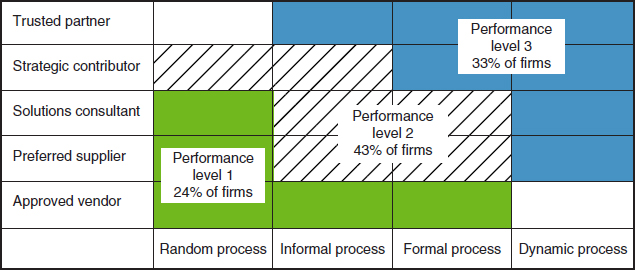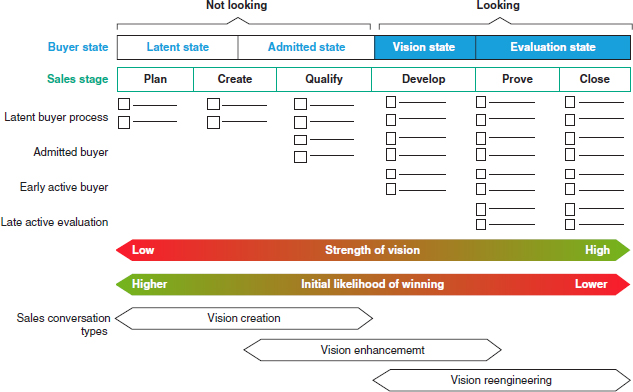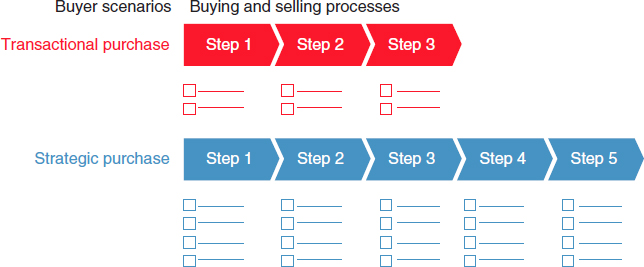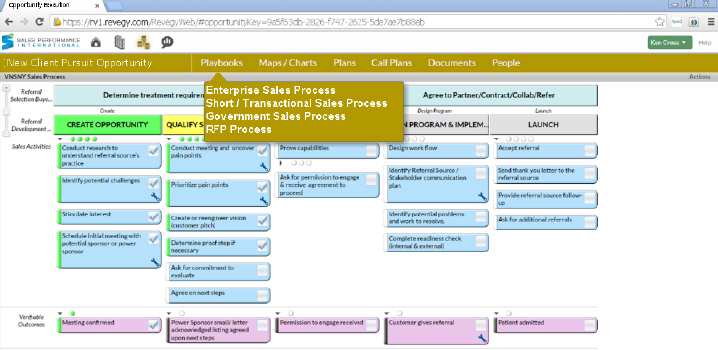7 Establishing a Dynamic Sales Process
In 2012, a CSO Insights survey of more than 1,400 sales executives found that nearly nine out of every 10 organizations that implement a defined sales process report significant improvements in business performance.1
One of our clients, Microsoft, was able to confirm and quantify the value of its sales process implementation. To accomplish this, it established a control group of sellers who utilized the Microsoft Solution Selling Process, while all other sellers did not. They then compared sellers’ performance results for each group over two years.2 See Figure 7.1 for results from the comparative study.
The performance of sellers utilizing the Microsoft Solution Selling Process was far superior to the worldwide average of sellers not using the sales process. In particular, sellers using the sales process produced much better customer satisfaction ratings. Why? Those sellers were better at setting and managing customer expectations. They accomplished this through improved conversations; they had learned how to diagnose buyer problems and create visions of solutions that were realistic.

Figure 7.1 Microsoft Solution Sales Process Results
Source: Microsoft Internal Study, Summer 2006, Microsoft
Corporation, Redmond, Washington. Published with permission of Microsoft.
In addition to improved customer satisfaction, those who used the sales process realized improvements in quota attainment as well. The most significant difference was in the percentage of sellers achieving their quotas. The number of sellers using the Microsoft Solution Selling Process who achieved or exceeded their quotas increased significantly.
As Figure 7.2 indicates, CSO Insights also discovered a correlation between the level of sales process implemented (described as random, informal, formal, and dynamic) and the levels of customer relationship (categorized as approved vendor, preferred supplier, solutions consultant, strategic contributor, and trusted partner). In short, the more mature the sales process definition, the higher the general level of customer relationship.

Figure 7.2 Relationship of Sales Process Maturity and Level of Relationship
Source: Sales Performance Optimization Report, CSO Insights, 2012.
www.csoinsights.com. Chart reproduced with permission of CSO Insights.
Why do some sellers achieve trusted partner status with buyers, while others can attain only lower relationship levels? In Figure 7.3, we define five different levels of customer relationship. We have observed that most sellers’ opinions of how their customers view them are higher than their customers’ actual opinions. In addition, sellers’ actual relationship level will likely vary with different customers. The goal, however, is to strive for the highest level—trusted partner.
The key to gaining higher levels of buyer relationship is the seller's situational fluency. The better sellers develop their situational and capability knowledge along with their people skills, selling skills, and collaborative attitude, the more insightful and valuable will be the conversations that they can have with buyers, and therefore the higher the level of relationship they can achieve.
The combination of sales process and customer relationship translates into significantly better sales performance. The top tier of sales organizations—what CSO Insights calls Level 3, attained by one-third of the survey respondents—operate with the highest levels of both sales process and buyer relationship. They report the best aggregate average results for:
- Sales team goal attainment
- Individual sales goal attainment
- Forecast accuracy
- Sales staff turnover reduction
- Adoption and usage of customer relationship management (CRM)3
Some observers of sales methodology argue that since Buyer 2.0 engages with sellers later in their buying process, the value of a defined sales process is now greatly diminished. However, this belief does not hold up against research findings. The Microsoft results and the CSO Insights studies prove that implementing a defined sales process is strongly correlated to customer satisfaction and relationship, and to improved business results.
The reason for this is that Buyer 2.0 does not make purchase decisions randomly. Today buyers use a rational sequence of events to identify business issues or opportunities, define corresponding needs and requirements, evaluate alternatives, and assess the risks of making a decision. Buyer 2.0 moves through the psychological phases of evaluation and decision in a fairly predictable and consistent way. A defined sales process that aligns with Buyer 2.0's behavior enables sellers to collaborate in harmony with buyers’ concerns, and help them to a buying decision.
In previous chapters, we defined the three personae needed to engage collaboratively with Buyer 2.0—the Micro-Marketer, the Visualizer, and the Value Driver. In order to assume the right persona at the right time, sellers need to have some context based on where a buyer is in the buying process. A dynamic sales process, one that aligns with a variety of buying scenarios, helps sellers to understand this context and therefore what persona they should assume to engage effectively with Buyer 2.0. This is why the three personae of The Collaborative Sale work so well, as they enable sellers to align with the concerns of Buyer 2.0 as they progress through the buying phases.
The question is not whether a sales process provides value, but rather: does a sales process look different today, given the changes in buyer behavior? We have found that in order to help sellers engage more collaboratively with buyers, an evolution of sales process is needed. A more dynamic sales process is required to align with Buyer 2.0.
Buyer-Aligned Sales Process
A process is a systematic series of actions, or a series of defined, repeatable steps, intended to achieve a reliable result. When followed, these steps can lead consistently to predictable outcomes.
Our automobiles, for example, are assembled using manufacturing processes, as are our clothes, our homes, and even the foods we eat. Each relies on defined processes to ensure quality and consistency. Imagine what our automobiles might look like if they were constructed haphazardly, without a defined manufacturing process, and how unsafe and unreliable they would be. Similarly, a sales effort without any direction or definition too often leads to unfavorable results—or increasingly, to no result at all.
A buyer-aligned sales process, however, is different from other kinds of processes in one important way. While a good selling process includes recommendations for seller actions and best practices, progress and success are measured by the observed verifiable outcomes, not by the activities executed. The reason for this is that verifiable outcomes demonstrate validations of human behavior. Sales process is not an exact science.
A verifiable outcome is a behavior that shows the degree of alignment between a buyer and the seller—and those behaviors are always executed by the buyer, not the seller. This aspect is what makes this a buyer-aligned sales process, not just a selling process—and this distinction is vital for enabling sellers to collaborate successfully with Buyer 2.0.
Verifiable outcomes can be captured as evidence of progress with a buyer. For example, after an initial meeting with a buyer, a seller can summarize the results of that conversation in an e-mail, sent back to the buyer. The verifiable outcome is how that buyer reacts to that message. Does the buyer confirm the conclusions of the seller and agree to next steps? Or does the buyer amend or change those conclusions? Or does the buyer not react at all? The observed behavior tells the seller the degree to which he or she is aligning with a buyer.
Dynamic Sales Process
Buyer 2.0 is changing the face of sales process in such a way that a single picture or simple linear view no longer represents what is needed. Driving the need for process flexibility is how buyers now engage sellers. For example, a traditional sales process step covering activities for initial discovery will not be applicable for every opportunity with Buyer 2.0, who generally engages sellers later in the buying process. Today, a sales process must reflect multiple buying scenarios, with different points of initial engagement with Buyer 2.0, as shown in Figure 7.4.
A “one size fits all” sales process is no longer applicable to engaging with Buyer 2.0. Today, sales organizations use many different go-to-market models to connect with buyers. A sales process defined for an inside sales team will be different from one for a direct or channel sales team. Within each model, there can be multiple variations of sales process dependent on the buyers served, complexity of the solution sold, and typical length of the buying process, as illustrated in Figure 7.5.
For example, one of our clients, Emerson Process Management, offers individual products, such as an advanced pump for a manufacturing line, and also larger strategic solutions, such as fully integrated plant control systems. The individual product sale tends to be shorter, is focused on fewer people in the evaluation process, and is more tactical than the strategic solution sale, which tends to be longer with a more rigorous evaluation, a larger group of evaluators, and more complex requirements.
Emerson Process Management has therefore defined two types of buyer-aligned sales processes, one for transactional sales and another for more strategic sales, to reflect these typical kinds of buyers. Sellers use either type of process as a guide, depending on the situation and what is most appropriate to that particular opportunity.

Figure 7.4 Dynamic Sales Process: Multiple Points of Initial Engagement
The actual number and names of sales stages may vary, depending on the nature of the buyer constituencies served and relevant solutions sold. Recommended seller actions for different points of initial buyer engagement are critical for an effective dynamic sales process definition.
Optimally, buyer-aligned sales processes should be designed to cover the most typical buying scenarios, but not every conceivable type. A good rule of thumb is to develop process definitions that ensure alignment for the majority of typical buyer scenarios—more is good, but absolute perfection is not required. Any situations that do not align perfectly with defined processes are, by definition, exceptions, and should be managed accordingly. In fact, defining dynamic buyer-aligned sales processes makes the principle of “management by exception” a clear decision, instead of an arbitrary or subjective one.
Automating Dynamic Sales Processes
While a diversity of sales process definitions may seem overwhelming or complex, it can be made simple by providing sellers with a playbook—a guide for best practices for each of the typical sales situations they encounter. A playbook provides sellers with advice for effective activities, tools, and conversations targeted to each scenario. In addition, providing a playbook that covers multiple sales processes using an automated tool within a CRM system can make it easier for sellers to select and apply the most appropriate option for the particular scenario they are encountering with a buyer.
An application platform that supports development of a playbook of dynamic sales processes for use in different sales scenarios can help sellers to align with Buyer 2.0 more accurately, and therefore, execute the right actions that will be of most benefit to both the buyer and the seller. (See Figure 7.6.) We explore the implementation of automated playbooks in more detail in Chapter 9.
Expanding the View of Sales Process
It is not enough simply to have a sales process. The sales process's philosophical underpinnings must be based on collaboratively solving customer problems—it must be customer focused and solution based. To be a little more granular, this means it is not just about “what to do”; the process needs to be supported with methodologies covering “how to do it” as well.
The sales process definition should include all end-to-end actions that lead to increased performance. Many people think of sales process only in the context of sales execution—the direct interaction with a buyer focused on a specific sales opportunity—but this is too limited a view. An effective sales process definition should also include relevant sales planning steps and methodologies.
Planning methodologies at the channel, territory, account, and opportunity levels are typically conducted on a periodic basis—every year, quarter, month, or week, depending on the customary management review cycle of a particular business. These methodologies support and integrate with the sales execution process at the opportunity level, which focuses on day-to-day selling activities with buyers.
Figure 7.6 Dynamic Sales Process Playbooks
This is an example of an automated dynamic sales process and the user interface for a seller using the Revegy platform within a CRM system. This platform supports multiple playbooks that align with the types of buyer with whom a seller may engage. It allows the seller to use the optimum sales process for each buyer scenario.
Collaboration is essential in most supporting planning methodologies. For example, account planning ideally should be conducted jointly with the customer and also involve relevant sales team and customer support resources. Collaboration goes beyond opportunity management and sales execution, and should be a part of any sales methodology utilized.
Each of the sales planning methods could be a stand-alone process; they are their own processes. We are not defining planning methodologies in detail within this book, as we are focusing primarily on the process of sales execution and alignment with Buyer 2.0. However, planning methodologies can and should be supported in conjunction with sales execution on a common automation platform, which makes integration and user compliance easier. An automated platform can help to integrate sales methodologies seamlessly to ensure quality completion of both planning and sales execution tasks. (See Figure 7.7.)
Sales Process Enables Management and Marketing
Sellers are not the only beneficiaries of defined standards for a dynamic buyer-aligned sales process. Marketing can use playbooks to equip and enable sellers to diagnose buyer situations, position appropriate solutions, and manage concerns about risk. Process definitions and associated playbooks also provide standards for first-line sales managers and executives for use in coaching and sales forecasting.
With playbook definitions, marketing professionals can understand what sellers need to help them align with buyers better—the messages, enabling tools, and collateral materials that would be of the most help in different buyer scenarios. Further, a dynamic sales process provides common standards for developing marketing messages that are most compatible within the context of a sales process. In our previous book, The Solution-Centric Organization, we described how sales and marketing can be aligned to work together seamlessly.4 Definition of a dynamic sales process is the common ground upon which sales and marketing can integrate their efforts.

Figure 7.7 Example of an Automated Account Planning Methodology
This is an example of a user interface screen for an account planning process using the Revegy platform. By using a common platform for planning and sales execution methodology support, integration and user compliance are easier to accomplish.
Executives can also use dynamic sales processes to tabulate forecasts of future business, based on the cumulative likelihood of winning opportunities. Using a dynamic sales process, the likelihood of winning can be based on the degree of alignment with buyers, the progression through the buying process, and the expected date of a buyer decision, all proven by observed verifiable outcomes. Using objective criteria, the accuracy of dynamic sales process forecasts will be higher than those derived from compiled subjective estimates from sales managers.
With a definition of “what good looks like” in dynamic sales processes, managers can evaluate the status of opportunities more accurately, assess the quality of each opportunity, and coach sellers to an agreed-upon standard of excellence. Without a definition of sales process, managers have few benchmarks to compare an opportunity against, making it difficult if not impossible to ascertain its true status, or to determine the optimal actions a seller should apply. In the next chapter, we further explore the use of sales process to coach sellers in the Collaborative Sale.
1Sales Performance Optimization Report, CSO Insights, 2012. Also at www.csoinsights.com.
2Microsoft Internal Study, Summer 2006. Comparative analysis of Microsoft Solution Sales Process on seller performance, based on worldwide customer satisfaction surveys and internal interviews. Published with permission of Microsoft Corporation, Redmond, Washington.
3Sales Performance Optimization Report, CSO Insights, 2012. Also at www.csoinsights.com.
4Keith M. Eades and Robert E. Kear, The Solution-Centric Organization (New York: McGraw-Hill, 2006).



